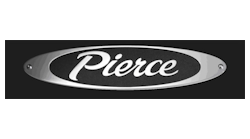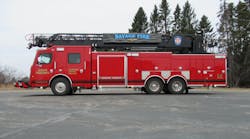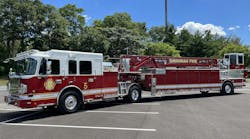Picking a ladder or platform aerial is a lot like choosing chocolate or vanilla, chicken or beef—it’s mostly a matter of preference. Both types of aerials will provide the basics—rescue, ventilation and extinguishment—but they do so differently and that difference can be significant to individual communities.
Take Winter Park, FL, for instance. The suburban Orlando community is mature with well-established roads, many lined with oak trees. In 2003, after two years of training and planning, the city formed it’s first-ever truck company, according to Winter Park Fire Chief James E. White who offered a “five-bugle perspective” of the process.
The department selected a rear-mount platform aerial for its first aerial, he said, noting the process was well thought out, but in practice the truck wasn’t the best suited for the operations the city intended.
“We are what you might call geographically challenged,” White said. “We have very tight streets and accessibility is challenging.”
White said his department is always assessing the quality of service of his department by “measuring outcomes.” He said doing the research, it became apparent the fixed-frame platform aerial was not cut out for Winter Park.
“Essentially, we were putting a big crane on the road every time we had a call,” White said. And it couldn’t get to some areas because of accessibility issues. The aerial bucket was damaged many times because it hit objects and, in Winter Park, damaging a tree is the equivalent of damaging a family heirloom—just something you didn’t want to do.
From platform to straight stick
So, White said it was time for the aerial to go, even though it was still in good shape and continues to provide service to a department in North Carolina.
The decision to replace the platform provided an opportunity to really assess what the community needed. The department used what White calls “smart design.” He said custom apparatus means more than picking out the light bar and paint color—rather it should be designing the apparatus to meet the needs of the community.
The decision was to dump the platform in favor of a straight stick to gain some clearance for travel height and improved accessibility, White said, noting that the department put the 100-foot ladder on a tractor-drawn tiller. The design allowed significantly improved maneuverability to places where the platform could never access.
“The first discussion was ‘how do we deal with this, it’s not a platform,’” White said. “What we got was improved ladder placement and greater capabilities.”
White said the platform was actually a quint, but it was never really used in that capacity and it was seldom used as a ladder either because of the difficulties it presented. And, because his department is focused on outcomes, White said the numbers show the ladder company has a 20 percent faster response time with the tiller and the aerial device is deployed at virtually every scene, whether it’s used or not because it’s easier to deploy and use.
Now, the department is specifying apparatus to support the aerial by purchasing two pumpers that will complement the tiller’s functionality.
“We took the opportunity to look at what we really needed rather than saying, ‘we want one of those because they’re cool,’” White said. “We were able to prove the outcomes. Taxpayers today don’t put up with cool, so we had to prove what we needed. When you’ve got a million bucks in apparatus out on the street, that’s different. That’s huge. We had to convince the community it was the right thing to do.”
The transition
Winter Park Division Chief Jimm Walsh was with the department from the inception of the truck company program and worked with both the platform aerial and straight stick tiller.
“It was a difficult decision to get rid of the platform and go with the tiller,” Walsh said. “We lost our bucket. Our ladder company was born on a platform, so we had to re-think it.”
For starters, Winter Park firefighters were used to having all the equipment they needed for roof operations carried up in the platform for roof operations and riding up to the top with it.
To compensate for the loss of the bucket, Walsh said the department specified the aerial with two scabbards to accept chainsaws and a sling system to fly the rotary saw to the roof. Walsh said they wanted to make sure they could have “unencumbered climbing” on the ladder. They also want to make sure they had the right saw for whatever material they encountered, metal or wood.
Walsh said the new straight stick tiller is lower than the platform, is centered and protected from the oak trees that seemed to diminish the platform’s ability significantly. Firefighters now find it’s much easier to poke the straight stick through the trees to get to the buildings on the other side. Previously, the platform had a much larger profile and it was far more difficult to find holes in the tree canopy to fly the platform through, he added.
Another advantage of the straight stick ladder is it can provide a means of escape that is more efficient than a platform. The platform can only take a limited number of people and there’s time factor in raising and lowering the bucket to transfer people to the ground.
“You could possibly get 30 people out of a building in the time it takes to get just two out with a platform,” Walsh said, qualifying his statement by adding that people in need of rescue need limited firefighter intervention.
Walsh said fire departments need to protect the working space at the tip of a straight stick. There’s a tendency to load up the tips with huge lights, waterways and monitors. He said LED lights take up much less room than the legacy halogen lights, so he recommends departments consider that option.
Some departments try to use aerial devices as light towers or for deluge purposes as an elevated master stream, he said. He suggested the need to seriously consider what use the valuable and limited real estate at the tip of a straight stick offers. They don’t accept the same number of options as platform aerials.
Having lived through the transition from the platform to the straight stick, Walsh said the thing he misses the most is the ride to the roof. Now they have to climb, which is not a huge deal because the Winter Park firefighters routinely climbed the platform because it was designed as more than just an emergency escape route, Walsh said.
He also said he misses the ability to use Stokes baskets to remove victims from elevation. Now, the department uses ropes to lower Stokes baskets and victims rather than the platform.
Even with the loss of some features, Walsh is sold that the straight stick tiller is the right decision, four years after the start of the great experiment.
“There are pros and cons with everything,” Walsh said, adding that the tiller has far more benefits for Winter Park than detriments.
Aerial innovations
Lisa Barwick, director of business development for aerial products for apparatus builder Pierce Mfg. in Appleton, WI, said the Ascendant is an excellent product for a variety of communities to consider while determining their aerial needs.
“It really comes down to customer choice,” Barwick said. “There are advantages to both.”
The straight ladder, Barwick said, is a “basic tool” that will perform rescue, ventilation and extinguishment operations very well.
Some of the advantages of a straight tip ladder is the apparatus needed to carry them are smaller in size than platform aerials. They typically have shorter travel heights to more easily miss tree lines, electric lines and are often more maneuverable.
Barwick said ladders have some flexibility with waterways, which can be pinned back to prevent damage, they generally have a shorter stabilizer stance and overall, they are compact and more able to maneuver city streets.
Platforms will also perform all three aerial operations (rescue, ventilation and extinguishment), but generally with more comfort and safety. Platform aerials are, however, bigger and heavier. But with that trade off comes higher tip-load ratings and water-flow ratings.
“Platforms provide much safer evacuation operations,” Barwick said, adding it allows victims and firefighters to ride rather than climb to the roof or wherever firefighters are needed. She said many firefighters prefer to ride to the roof to preserve their energy for the mission, a serious consideration given the aging population of firefighters.
Barwick is quick to point out, however, that the decision on which to choose is based on landscape and operations within the district the aerial will operate.
“They both have lots of advantages,” she said.
Aerial assessments
Every community should do an “aerial assessment,” she said, adding that Pierce sales representatives and dealers are encouraged to spend time talking to their customers to really determine what will fit best for their needs.
“We want them to talk about the city and to take time to drive around and assess the city and determine what kinds of buildings they have, their heights, the setbacks,” Barwick said.
Some communities might be in heavily wooded aerials that could be problematic for platform aerial equipment as would short overpasses and bridges that would limit travel height, she said.
“If you can’t get from A to B, and do so safely, it’s probably not the right truck for you,” she said.
Barwick said departments have a lot to work through like determining if they have more cul-de-sac and round-about roadways. Platform aerials are generally longer than straight stick aerials so maneuverability might be difficult in those settings, she said.
Building types, like commercial strip malls, or retirement high-rise apartment complexes might lend themselves better to platform aerials, so firefighters can move from window to window helping evacuate fire victims.
Platforms are generally more expensive to purchase than straight sticks, which could be a factor in the decision-making process, Barwick said. Platform aerials have baskets that hang over the front or rear which needs to be considered, have bigger engines and weigh more. All of those factors add up to additional acquisition costs, she said.
Barwick said Pierce’s new Ascendant line of aerials bridges the gap between straight stick and platform aerials.
“The nice thing about the Ascendant is that it falls between those two,” Barwick said. “It stays maneuverable, with a single axle, and you can have a platform at the end.”
“We like sales reps to have customers go through the buying criterion and ask thought-provoking questions,” Barwick said. “We want the community to understand how they made the decision and how they are going to use the aerial.”
Barwick said the best thing to do when selecting the type of aerial a community needs is to talk and assess the community’s needs as thoroughly as possible.
“There’s a lot of assessment that needs to be done,” Barwick said. “You need to talk through things and think through things before making any purchase.”







